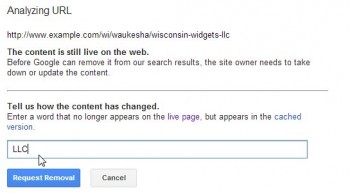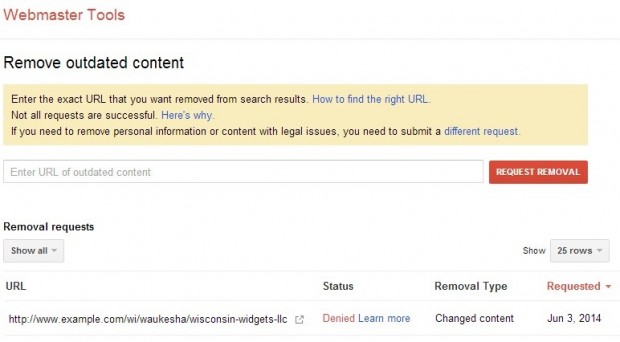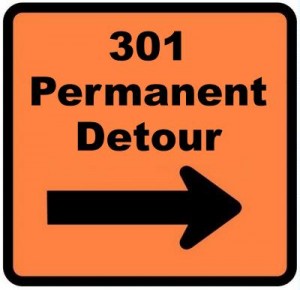In a white paper published by Yext called ‘The Definitive Guide to Duplicate Listings‘, Andrew Shotland suggests 3 ways that IYP websites can handle duplicate listing URLs. In the section called ‘Best SEO Practices for Publishers Dealing With Duplicates’ he recommends that publishers:
1. 301 Redirect Dupes To The Canonical Listing
2. Or Use Canonical Tags
3. Or 404 Them
When IYP venues use the canonical tag method, I often see an outdated duplicate URL which contains traces of the ‘old’ listing info. For instance, when the listing URLs are based on the company name, address, and/or phone number (NAP) info. This old, outdated URL is most often indexed in the search engines.
When the NAP info is updated in a listing, the new, canonical, URL is different from the old URL because the text of the URL is based on the new NAP info. Though you can visit both URLs, they will both show the same, updated, listing data.
I was wondering about the ramifications of this situation in the search engines, as I often attempt to get the outdated URL removed from Google SERPs as soon as possible (especial for reputation management projects).
 To get the URLs removed from Google’s SERPs, I use Google’s URL removal tool. It is much harder to get a URL removed from Google’s index if it doesn’t throw a 404 error, that is, when the URL still contains some of the old NAP data.
To get the URLs removed from Google’s SERPs, I use Google’s URL removal tool. It is much harder to get a URL removed from Google’s index if it doesn’t throw a 404 error, that is, when the URL still contains some of the old NAP data.
In order to submit the URL for removal or cache update, you need to provide Google with a keyword from the old listing page that no longer exists at that live URL. Sometimes the only information in a listing that may change is the company’s name. For example ‘Wisconsin Widgets LLC’ becomes ‘Wisconsin Widget Company’. In this case I would normally submit the word ‘LLC’ as the keyword that no longer exists in the listing.

However, since the “LLC’ is still contained within the old, duplicate URL, such as: www.example.com/wi/waukesha/wisconsin-widgit-llc … the request gets rejected by Google because the URL still contains the word ‘LLC’ in it, though the listing data itself does not. (I ran into the use of the ‘canonical tag’ method today on Angie’s List, which spurred this post)
In the case of the Angie’s List listings, if you view the HTML source code on both the old listing and the new listing, you can see the use of the ‘canonical’ tag, where the HTML code of both listings point to the ‘good’ listing as the authoritative, proper listing (which is a good thing).

The downside of this, however, is that there are still two ‘live’ listing URLs and the old one will most likely only be removed from Google’s SERPs when they choose to re-crawl the page and recognize the canonical tag AND then choose to remove the non-canonical URL in favor of the canonical URL (that is, IF the canonical URL is already indexed, I would think). One could submit the new URL to be crawled by Google and just wait until Google’s cache cleans itself up, eventually, however the old listing URL will still be accessible by direct or referral traffic visits. A potential customer could see the old NAP info in the old URL, which is not a good thing if you are trying to distance yourself from an old company address or business name.
 Using a 301 redirect of the old listing URL by the IYP venue to the proper listing would still present the same indexing issue, however, the old URL won’t be displayed to website visitors. More importantly, a redirect will keep any third party backlinks to that listing functioning. For example, some of our clients like to point to their IYP listings from within their own website or marketing campaigns in order to request reviews of their businesses. If the URL is properly redirected, these links would get forwarded to their proper locations.
Using a 301 redirect of the old listing URL by the IYP venue to the proper listing would still present the same indexing issue, however, the old URL won’t be displayed to website visitors. More importantly, a redirect will keep any third party backlinks to that listing functioning. For example, some of our clients like to point to their IYP listings from within their own website or marketing campaigns in order to request reviews of their businesses. If the URL is properly redirected, these links would get forwarded to their proper locations.
Using canonical tags does not seem like the best method for dealing with duplicate listings on an IYP venue. though it could be more useful when it is actually necessary to have duplicate content (such as when webpages exist in multiple languages). Having an old/outdated listing 301 redirect to the new listing is the favorable situation for internet yellow pages type websites.
If you need help eliminating duplicate listings for your company, please contact us now to receive a free quote for our business listing correction and optimization services.
